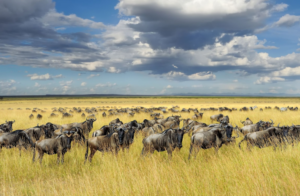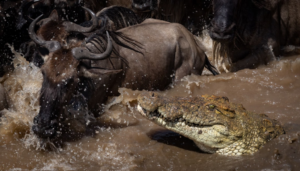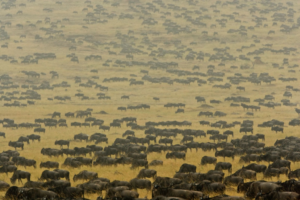The Great Migration is one of the most spectacular wildlife events on the planet. Every year, over two million wildebeests, zebras, and gazelles travel from Tanzania’s Serengeti National Park to Kenya’s Masai Mara Game Reserve, covering a distance of 800 km.
This annual event attracts thousands of tourists from all over the world, who come to witness the magnificent display of nature’s power and majesty.
In this article, we will delve into the Great Migration in the Masai Mara and explore its significance, history, and impact.

The Great Migration has been happening for thousands of years, but it was only in the 20th century that it gained attention from the outside world. In the 1920s, British colonists started to hunt Wildebeest for their meat, and this led to a decline in their population.
It wasn’t until the 1960s that conservation efforts began, and the great migration was recognized as a natural wonder worth protecting.
Today, the Great Migration is a major tourist attraction, and it generates significant revenue for the Kenyan economy. However, it is important to note that the migration is not just a spectacle for tourists but is a crucial part of the ecosystem. The migration is an essential process that maintains the balance of the ecosystem in both the Serengeti and the Masai Mara.

The Great Migration is an annual event that occurs in a cyclical pattern. It begins in Tanzania’s Serengeti National Park in January and February when over 500,000 wildebeests are born.
As the rainy season comes to an end, the wildebeests begin to move north, towards the Masai Mara. Zebras and gazelles join them, and together they form a massive herd of over two million animals.
The journey is not an easy one. The wildebeests have to cross the Mara River, where they are at risk of being attacked by crocodiles. The river crossing is one of the most dramatic moments of the migration, and it draws large crowds of tourists every year.
Once they have crossed the river, the animals graze on the Masai Mara’s lush grasslands, which provide them with much-needed nutrients. The grazing continues until November, when the animals start to move back to the Serengeti, in search of greener pastures.

The Great Migration is significant for several reasons. Firstly, it is a natural wonder that attracts thousands of tourists from all over the world. The tourists who come to witness the migration contribute significantly to the Kenyan economy, through tourism revenue.
Secondly, the migration is essential for the ecosystem’s balance. The wildebeests, zebras, and gazelles are crucial in maintaining the grasslands’ health, through their grazing habits.
The grasslands, in turn, provide a habitat for other animals, such as predators, birds, and insects.
Thirdly, the migration is a cultural heritage of the Masai people, who have lived in the region for centuries. The Masai people have a deep connection to the land and its wildlife, and they have traditionally coexisted with the animals. The migration is an important cultural event for the Masai people, who see it as a symbol of their connection to the land.
While the Great Migration has several positive impacts, it also has some negative effects. One of the most significant impacts of the migration is the strain it puts on the ecosystem. The massive herds of animals can quickly deplete the grasslands’ resources, leading to overgrazing and soil erosion.

Additionally, the influx of tourists during the migration season can have a negative impact on the environment. The increased foot traffic can disturb the animals’ natural behavior whilst migrating and disrupt their habitats. It highlights the importance of implementing responsible tourism practices and prioritizing environmental conservation efforts. By minimizing human interference, preserving natural habitats, and promoting sustainable tourism, we can ensure that future generations can continue to witness the awe-inspiring Great Migration without compromising the delicate balance of the ecosystem.
The Great Migration in the Masai Mara is a magnificent display of nature’s power and splendor. Its historical significance, ecological impact, and cultural value make it a truly remarkable event. By balancing conservation efforts, responsible tourism, and sustainable practices, we can ensure the long-term preservation of this incredible phenomenon, allowing future generations to witness and appreciate the wonders of the Great Migration.
Featured image by Mihaela Istrate from Pixabay

